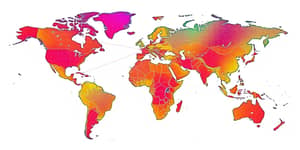In a world where financial services once meant long queues, stacks of paperwork, and opaque approval processes, fintech has shattered old paradigms. Today, borrowers from New York to Nairobi experience a revolution in access and speed. By weaving together cutting-edge technologies, dynamic regulation, and social impact goals, fintech lending has leapt beyond traditional boundaries, creating opportunities for millions. This article explores the forces driving this transformation, the challenges ahead, and how you can harness these changes to build a more inclusive and efficient lending ecosystem.
The Rise of Fintech Lending: A Global Perspective
From a market size of $508.31 billion in 2024 to a projection of $589.64 billion in 2025, fintech lending is more than a trend—it’s a seismic shift. Analysts forecast a compound annual growth rate (CAGR) of 16%, propelling the industry toward a staggering $1.7 trillion valuation by 2033. Alternative platforms, including crowdfunding and marketplace lending, disbursed over $350 billion by 2023. With 17.6% CAGR between 2020 and 2023, this growth outpaces many traditional finance segments, underlining how digital-first models capture unmet demand across the globe.
North America and Europe currently lead, but the Asia-Pacific region, driven by China, Japan, and India, is rapidly surging. Latin America’s 22% CAGR and Africa’s jump from 7% to 12% penetration signal untapped potential in emerging markets.
Disrupting Tradition: Key Market Segments
Fintech lending encompasses a spectrum of services that challenge conventional banking. By focusing on agility, user experience, and data-centric assessments, these platforms deliver tailored finance solutions for consumers and businesses alike. Understanding these segments helps identify niche opportunities and consumer needs.
- P2P consumer lending connecting individuals for direct loans
- P2P business lending fueling small enterprises and startups
- Private lending and platform-driven syndicated loans
- SME and corporate financing unlocking working capital
- Specialized verticals such as mortgages, microloans, and buy-now-pay-later
Key Drivers of Growth and Innovation
Several interlocking factors underpin fintech’s rapid ascent. By harnessing digital tools and prioritizing customer-centric models, fintech lenders reduce frictions and expand reach. Below are the primary engines propelling sector expansion:
- Technology adoption: AI, machine learning, and big data analytics
- Mobile banking and digital onboarding: broad smartphone and internet penetration
- Rising financial inclusion: serving unbanked and underbanked populations
- Cost and efficiency: streamlined operations with reduced fees
These drivers reinforce each other: mobile access fuels bigger data sets for AI, while cost savings enable more competitive rates and broader outreach.
Pioneering Technologies Powering Change
Innovations are central to fintech’s value proposition. Companies that marry robust risk models with seamless user experiences are outpacing legacy institutions. Key technological trends include:
AI-driven decision-making allows for predictive risk modeling and fraud detection in real time. Open APIs and embedded finance break down silos by integrating lending services directly into shopping, gig economy, and enterprise platforms. Personalized offerings, based on behavioral insights, deliver tailored loan products that resonate with individual needs. Meanwhile, the rise of green finance supports lending solutions that prioritize sustainability goals, and regtech advancements simplify compliance, ensuring platforms stay ahead of evolving regulations.
Bridging Gaps: Financial Inclusion and Consumer Benefits
Fintech lenders excel at reaching segments overlooked by traditional banks. By removing geographic and procedural barriers, they deliver credit to farmers, freelancers, and minorities who lack standard documentation or credit histories. Approval times shrink from weeks to minutes, offering unprecedented agility.
This shift fosters greater trust and loyalty. Transparent pricing models reduce hidden fees, and digital dashboards empower users to monitor repayments, manage schedules, and access support instantly. For millions worldwide, fintech lending means unprecedented access for underserved populations and a pathway to financial empowerment.
Navigating Regulatory and Risk Landscapes
While fintech thrives on innovation, it must align with complex regulatory frameworks. Europe’s supportive digital finance policies have stimulated growth, but global oversight remains dynamic. Companies face stringent requirements for customer due diligence, data protection, and capital adequacy.
At the same time, fintech platforms grapple with cybersecurity threats and the challenge of untested credit models during economic downturns. Establishing robust cybersecurity protocols and automated compliance systems is critical for building resilience. Firms that proactively engage with regulators and embed risk management into their culture will lead the market.
Challenges and Strategic Opportunities Ahead
Despite impressive momentum, fintech lending confronts headwinds. Data privacy concerns and evolving regulations can slow product rollouts. High growth periods may mask underlying credit risks, and market consolidation may squeeze smaller players.
Yet, challenges give rise to opportunity. Emerging markets in Southeast Asia, Africa, and Latin America represent significant white spaces. Partnerships with traditional banks, integrations with payment platforms, and ecosystem-driven alliances open new distribution channels. For entrepreneurs, focusing on niche verticals or underserved groups can drive differentiation and sustainable growth.
Charting the Future: Toward an Inclusive Lending Ecosystem
Looking ahead, the global fintech lending market is set to eclipse $1.7 trillion by 2033. Success will hinge on a balanced approach that marries innovation with responsibility. By prioritizing transparency, data security, and financial inclusion, stakeholders can build systems that are not only efficient but also equitable.
For fintech founders, investors, and policymakers, the mission is clear: embrace emerging technologies, foster collaborative ecosystems, and maintain customer-centric values. Together, we can reshape lending into a tool for opportunity, driving economic growth and social impact across every corner of the globe.
References
- https://www.cognitivemarketresearch.com/fintech-lending-market-report
- https://coinlaw.io/fintech-lending-statistics/
- https://kpmg.com/xx/en/what-we-do/industries/financial-services/pulse-of-fintech.html
- https://www.businessresearchinsights.com/market-reports/fintech-lending-market-117375
- https://www.siegemedia.com/strategy/fintech-statistics
- https://explodingtopics.com/blog/fintech-market
- https://hesfintech.com/blog/lending-trends-2025/
- https://www.startus-insights.com/innovators-guide/fintech-report/










